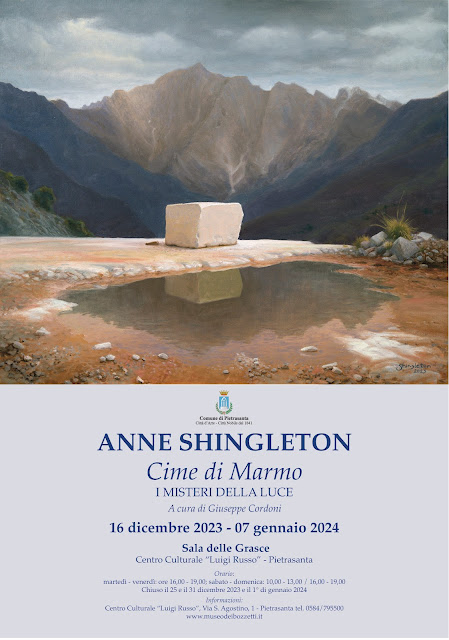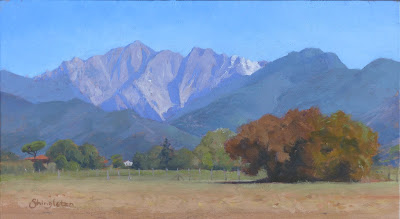Pensieri sulla creazione del ritratto in bronzo della Signorina Simi. (1890-1987)
 |
Ritratto in bronzo di Nerina Simi di Anne Shingleton. Altezza 55cm, dimensione naturale - altezza 55cm.
|
Prima di descrivere le emozioni provate nella creazione di questo ritratto scultoreo, mi piacerebbe spiegare come ho iniziato a studiare con la Signorina Simi e perché lei è diventata così importante per la mia vita d’artista ed anche per quella di molti altri.
Ai tempi pre-Internet, vi era un'opportunità su un milione di essere a conoscenza degli insegnamenti di Nerina Simi. ( Il suo vero nome era Nera, ma era spesso chiamata Nerina). Invece la sua fama fu sparsa per il mondo dai suoi innumerevoli studenti, ed è per questo motivo che ne sono venuta a conoscenza.
Erano i tardi anni Settanta in Inghilterra, ed avevo completato 3 anni d’università (specializzandomi in Zoologia) e 2 anni di scuola d’arte, e stavo lavorando da casa dei miei genitori, accettando qualsiasi lavoro che si presentasse come illustratrice, ritrattista e eseguendo anche incisioni all’acquaforte.
In quel tempo gallerie e istituzioni di ogni tipo incoraggiavano l’arte contemporanea ad essere astratta, all’esecuzione di istallazioni o di video. Anche se avessi provato l’impossibile, l’ambiente della arte britannica non mi avrebbe mai potuto offrire un futuro. Mi sono sentita esclusa.
Visitando un’esposizione privata dell’artista Pamela Russell, nella campagna della mia contea di Dorset, mi capitò di vedere dei quadri con una luce particolare. La pittrice mi raccontò che aveva studiato a Firenze, con una signora chiamata Nerina Simi. Questa signora, se ancora in vita, sarebbe stata molto anziana ma mi dette il suo indirizzo comunque perché io le scrivessi.
 |
| Stusio Simi, sul'angolo di Via Tripoli e Piazza Piave, Firenze. |
Per farla breve, nel seguente Ottobre del 1980, vi fu un’invito per lettera della stessa Signorina, a cui seguì la mia risposta: un cingere ansioso del mio portfolio al suonare la campanella del suo studio in Via Tripoli n.1, a Firenze.
La mia presenza fu annunciata da una domestica piuttosto robusta che mi chiese di attendere in una piccola anticamera scura. Una piccola figura zoppicò lentamente lungo un corridoio verso di me. Era una signora leggermente piegata e dagli occhi brillanti; aveva i capelli avvolti in un chignon ed una fila di perle intorno al collo. Mi accolse in Inglese. Con un grande sorriso aggraziato scelse accuratamente le parole da dirmi e mi mise subito a mio agio. Avrei cominciato l'indomani. Vi potete immaginare l’emozione!
 |
| Foto dell'interno dello studio negli anni settanta. |
Mi trovai un cavalletto libero nel retro dello studio, lontano dalla modella in posa. Nerina Simi visitava ogni studente durante la sessione sia mattutina che pomeridiana. Da dove ero seduta potevo osservare i disegni di tutti e mi sembrava che andassero tutti così piano . . . .
Quando essa entrò nella stanza, avevo già buttato giù l’intera figura sul foglio e fui io la prima ad essere visitata. Con gentilezza e semplicità mi spiegò come misurare, come guardare e come tradurre le mie osservazioni sulla pagina, delicatamente con un carboncino appuntito. I miei errori vennero fuori ed il tutto, improvvisamente, apparve monumentale ed imbarazzante. Voltai la pagina e riniziai immediatamente.
 |
Nerina Simi con studente Joke Frima nei tardi anni Settanta.
|
Mentre iniziò ad indirizzarsi verso un’altro studente, dovetti nascondere le mie lacrime di sollievo e felicità. Finalmente per la prima volta nella mia vita, nel mondo dell’arte, non solo apprendevo le cose come stanno da qualcuno, ma la Signorina lo ha fatto in maniera cordiale e gentile. Questo era un linguaggio scientifico che mi era familiare. La decisione di venire da sola in Italia è stata molto stressante, ma in quel momento, sapevo di essere nel posto giusto al momento giusto.
 |
| Foto scattato di me nello studio quando facevo una visita informale con la mia famiglia nel 1981. |
La maggiorparte degli studenti presenti nella mia classe, ma non tutti, erano proprio come me, non-Italiani, donne, e molto giovani, così fu molto facile per me stringere amicizie. “La Signorina”, così nominata affettuosamente dai suoi studenti, fu una figura gentile di madre per tutti noi individualmente, e sapevamo bene che era un privilegio studiare con lei. Chi è rimasto ancora in contatto oggigiorno si considera parte di una famiglia molto speciale, anche se siamo a quasi 25 anni dalla sua scomparsa.
Ero stimolata dalla mia nuova vita come studente a Firenze. Avevo appena 25 anni e già avevo ottenuto un senso di libertà dalla mia educazione Inglese. Stavo letteralmente camminando lungo le strade familiari ai grandi talenti del passato; Donatello, Michelangelo e Leonardo da Vinci. Ogni giorno, fatta eccezione per la Domenica, sedevo con i miei compagni in una stanza dai soffitti molto alti ed intrisa di storia, dell’ Ottocento. In questa stanza erano presenti le opere di Filadelfo Simi, (1849 - 1923) il padre della Signorina: grandi quadri polverosi accumulati negli anni. L’insegnamenti che stavamo apprendendo erano un ponte tangibile attraverso la dottrina del padre, con l’atelier/studio di Jean-Léon Gérôme (1824 – 1904) che Filadelfo e altri grandi artisti del passato avevano frequentato. Essere nello Studio Simi era come essere sospesi in un attimo di tempo rimasto inalterato dal secolo antecedente.
 |
Una rara fotografia della Signorina sorridendo mentre non sospettava di essere fotografata.
|
Con il ricordo di quei 2 anni con la Signorina alle spalle e la mia nuova casa a Pietrasanta in Italia, una cittadina nota per la tradizione della scultura, decisi di creare un ritratto della maestra in creta. Volevo ritrarla come una forte, ma anziana donna, ancora motivata nel trasmettere la sua conoscenza. Essa continuò a ricevere i suoi studenti, insegnando fino a due mesi prima della sua scomparsa a 97 anni.
Trovare referenze fotografiche è stato un problema dato che era ben saputo che lei non amasse essere fotografata. Ma grazie all’aiuto di molti ex-studenti, che sottrassero qualche scatto di nascosto, sono riuscita ad ottenere abbastanza informazioni per le misure di base del profilo e della visione frontale del ritratto.
Gradualmente la creta ha iniziato a prendere forma, poi a trasformarsi in un ritratto, e con un po’ di buona volontà, a raggiungere somiglianza ed infine a diventare la Signorina. Quest’ultimo passaggio mi causò un’ineguagliabile soddisfazione. Ho provato la sensazione di averla ricreata. Che senso di potere!
 |
| Un particolare della scultura in creta bagnata. |
Da qui in poi, la scultura acquisì una presenza che mi ritrovai a considerare come se lei fosse veramente lì in persona. Al mattino le dicevo “Buongiorno Signorina” mentre toglievo il velo plastico dalla creta bagnata, e alla sera mi scusavo con lei prima di spruzzarla con acqua e rimpiazzarle il velo plastico con un “Buonanotte Signorina!”. Un giorno, mentre lavoravo con il naso vicino al suo braccio rialzato, in modo da poter elaborare i dettagli del viso, mi sono sorpresa di non potere annusare l’odore di una persona, ma invece, a percepire solo della creta molto, molto bagnata. Questo mostra quanto le mie emozioni siano state coinvolte nell’esecuzione di questa opera.
 |
| A lavoro nell'autunno 2019, con tutte le fotografie messo vicino come riferimento. |
Oltre a tramandare tecniche di pittura e di disegno, spesso, con un lieve senso dell’umorismo, la Signorina dava lezioni ancor più grandi che mi hanno sostenuto per tutta la vita; lezioni di perseveranza, di umiltà ed di grande apertura che hanno fatto sì che io raggiungessi nuove mete possibili. Lei non solo fu un’insegnante esperta e capace ma anche una pittrice nobilmente devota alla sua lunga vita d’arte, che al tempo era straordinario per una donna.
 |
| La scultura finita in bronzo patinato, 2020. |
Questa scultura rappresenta il mio ringraziamento alla Signorina ed un tributo per onorarne la memoria.
 |
| Un dettaglio della scultura in bronzo. |
Il metodo utilizzato per trasformare la creta in bronzo è complesso, ma spiegato sul mio sito: (http://www.anneshingleton.com/english/how-bronzes-are-made.html)















































